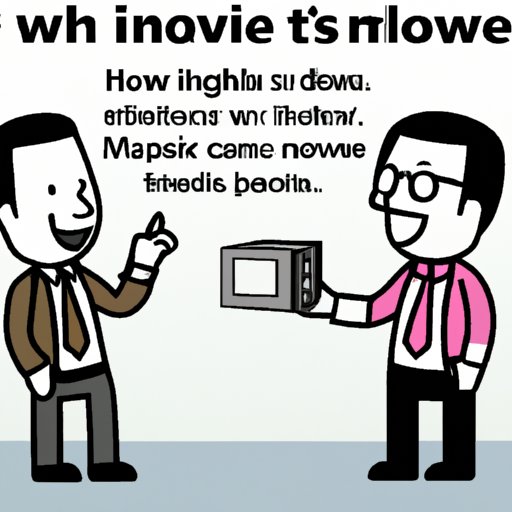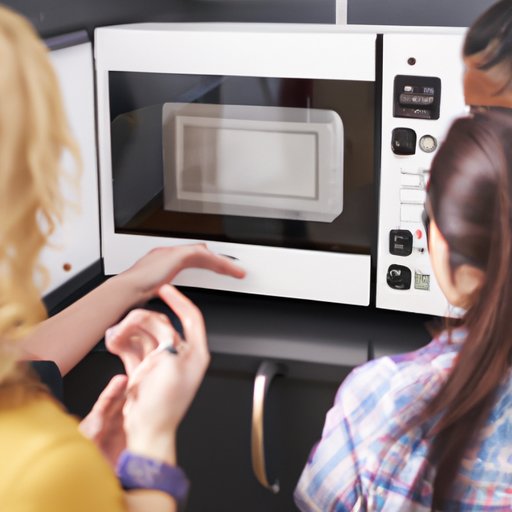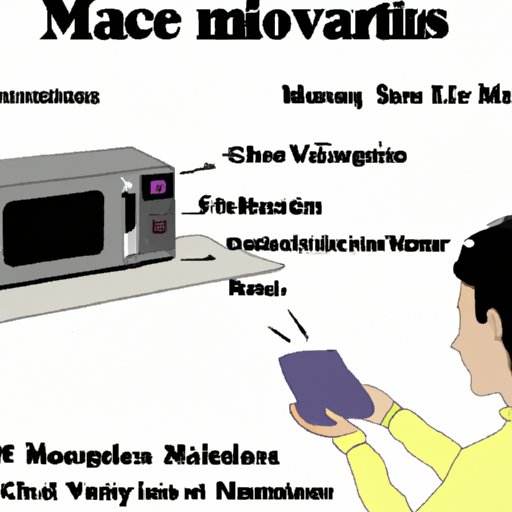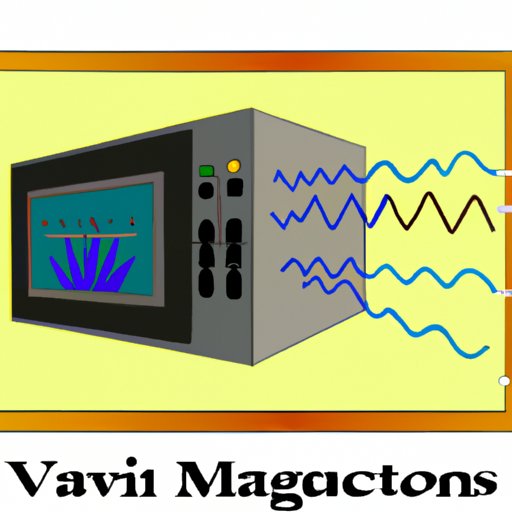Introduction
A microwave is an essential kitchen appliance that has revolutionized the way we cook our food. It is a fast, convenient, and efficient way to heat up meals in minutes. But how does a microwave work? This article will explore the science behind microwaves, the components of a microwave, the different settings available, and the benefits and risks of using a microwave oven.

Explaining the Science Behind Microwaves
Before exploring how a microwave works, it is important to understand the science behind microwaves. Radio waves are a type of electromagnetic radiation, which can be used to send messages or energy. These waves are produced by antennas, transmitters, and receivers, and can travel through air, water, and other materials. The frequency of radio waves determines their power and how they interact with matter.
Radio waves have the ability to heat food by vibrating the molecules inside it. When these molecules are exposed to the radio waves, they begin to vibrate and generate heat. This process is known as dielectric heating, and it is the same principle that powers a microwave oven.
The physics behind microwaves is based on the fact that the microwaves are generated at a specific frequency, which is tuned to the resonance frequency of the water molecules in food. This causes the molecules to vibrate rapidly, creating friction and heat. The heat generated by this process is then transferred to the food, cooking it quickly and evenly.
How Radiowaves are Used in Microwaves
There are several types of microwave ovens available on the market. The most common type is the countertop microwave oven, which uses radiowaves to heat food. These microwaves use a magnetron to produce the microwaves, which are then directed into the oven cavity through a waveguide.
The magnetron is a device that converts electrical energy into radio waves. The radio waves are then directed into the oven cavity through a waveguide, which is a hollow tube that acts as a conduit for the microwaves. The microwaves bounce around the oven cavity, heating the food as they come into contact with it.
In addition to the magnetron and waveguide, a microwave oven also contains a high voltage diode and a cooling fan. The high voltage diode is responsible for controlling the voltage and current that flows to the magnetron. The cooling fan helps keep the temperature inside the oven from getting too hot, ensuring that the food is cooked properly.
Demonstrating the Components of a Microwave
The components of a microwave oven include the magnetron, high voltage diode, waveguide, and cooling fan. The magnetron is responsible for producing the microwaves, which are then directed into the oven cavity through the waveguide. The high voltage diode controls the voltage and current that flows to the magnetron, while the cooling fan helps prevent the oven from getting too hot.
The magnetron is a device that converts electrical energy into radio waves. The radio waves are then directed into the oven cavity through the waveguide, which is a hollow tube that acts as a conduit for the microwaves. The microwaves bounce around the oven cavity, heating the food as they come into contact with it.
The high voltage diode is responsible for controlling the voltage and current that flows to the magnetron. It ensures that the right amount of electricity is being sent to the magnetron, so that it can produce the correct amount of microwaves. The cooling fan helps keep the temperature inside the oven from getting too hot, ensuring that the food is cooked properly.

Examining the Different Settings of a Microwave
Most modern microwaves come with a variety of settings that allow you to customize your cooking experience. The most common settings include the defrost setting, which is used to thaw frozen food; the reheat setting, which is used to quickly warm up leftovers; and the cook setting, which is used to cook food from scratch.
The defrost setting works by reducing the amount of time it takes for frozen food to thaw, allowing you to quickly prepare meals without having to wait for the food to thaw naturally. The reheat setting is useful for quickly warming up leftovers without having to wait for them to heat up in the oven. And finally, the cook setting is used to cook food from scratch, allowing you to quickly prepare meals in minutes.

Outlining the Benefits of Owning a Microwave
Owning a microwave oven has many advantages. One of the biggest benefits is the time-saving aspect. Microwaves are much faster than conventional ovens, allowing you to quickly prepare meals in minutes. This saves you time and effort, making it easier to whip up delicious meals in no time.
Another benefit of owning a microwave is that it is economical. Microwaves are much cheaper to run than conventional ovens, which means you can save money on your energy bills. Finally, microwaves can also help you cook nutritious meals. Because microwaves cook food quickly, the nutrients are retained, making the meals healthier and tastier.
Investigating the Dangers of Microwaves
While there are many benefits to owning a microwave oven, there are also some potential risks associated with them. One risk is radiation exposure. Although microwaves are generally safe, prolonged exposure to the radiowaves can cause damage to cells and tissues. To minimize the risk, it is important to make sure that the door is closed when the microwave is in use.
Another potential risk is fire hazards. Microwaves can generate sparks if there is something metal inside the oven, such as aluminum foil. To avoid this, it is important to avoid putting any metal objects inside the oven. Finally, microwaves can also interfere with other electronic devices, such as cell phones and radios, so it is important to keep them at a safe distance.
Conclusion
This article has explored the science behind microwaves, the components of a microwave, the different settings available, and the benefits and risks of using a microwave oven. Understanding how a microwave works and the potential risks associated with it can help you make informed decisions when using one.
It is important to be aware of the potential dangers of microwaves, such as radiation exposure, fire hazards, and interference with other devices. Knowing how to safely use a microwave oven can help you enjoy all the benefits it has to offer without putting yourself or your family at risk.
(Note: Is this article not meeting your expectations? Do you have knowledge or insights to share? Unlock new opportunities and expand your reach by joining our authors team. Click Registration to join us and share your expertise with our readers.)
